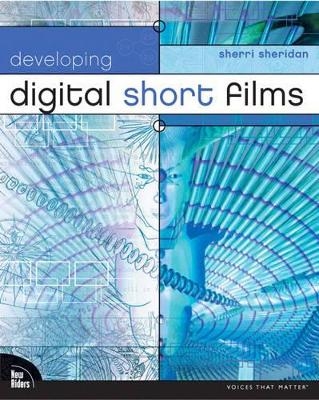
Developing Digital Short Films
New Riders Publishing
978-0-7357-1231-7 (ISBN)
- Titel ist leider vergriffen;
keine Neuauflage - Artikel merken
The film market is shifting toward traditional desktop technology to create productions...digitally. Unlike traditional film production, though, digital films require producers to employ a different pre-production process. Developing Digital Short Films explores how unique character and set designs, bluescreen ideas, special effects, and simple 2D character animation techniques can be used as narrative devices for telling stories. Part One focuses on generating visual ideas that are ideal for digital production and creating a short film script. Part Two focuses on the visual pre-production of a short film and the issues that go through a filmmaker's mind as they struggle with how best to present their stories; this includes topics like 101 camera shots, frame composition, developing a visual look and feel, color maps, and creating storyboards and animatics. Part Three explores the different production environments of DV, 2D and 3D, and how they shape the telling of stories based upon the technological strengths of each style.
Sherri Sheridan is the Creative Director at Minds Eye Media (http://www.mindseyemedia.com) in San Francisco, where she spends her time creating all sorts of digital projects. Over the years she has directed, produced, animated, written, and designed projects for a wide range of clients, including Fortune 500 companies, major record labels, TV/cable stations, feature-film studios, advertising agencies, and video game companies. She is the co-author of Maya 2 Character Animation (New Riders, 1999). Currently, Sherri is creating a series of international Developing Digital Short Films Workshops based on the ideas in this book. She is also writing, developing, and directing several original scripts for digitally enhanced shorts and feature films. Over the years, Sherri has helped inspire thousands of graduate computer animation students from around the world, helping them to tell their own stories using their favorite digital tools, at the Academy of Art College in San Francisco. While teaching these students, she started developing the foundation for a unique step-by-step digital visual storytelling process, which has grown into this wonderful book. Before founding Minds Eye Media in 1995, she helped develop Shockwave Technology at Macromedia, and created the first Shockwave movies on the web. Sherri has a BA in English from U.C. Berkeley and went to San Francisco State to study interactive design and computer animation for her graduate work.
Introduction.
Getting the Most Out of This Book. Becoming a Better Digital Filmmaker. Do Not Let Anything Stop You from Making Your Film.
I. DIGITAL STORYTELLING.
1. Generating Ideas for Digital Short Films.
Beginning the Story Concept Process. Character. Plot. Theme. Using Digital Tools to Create Original Films. Generating Original Ideas for Digital Short Films. Brainstorming for Software Capabilities. Incorporating Plot Goals. Final Story Concept Sentence to Pitch. Final Story Idea.
2. Creating Original Characters, Themes, and Visual Metaphors.
Creating Powerfully Original Characters. Developing Themes In Films. Using Metaphors and Symbols to Tell Stories.
3. Developing Plot Points.
Aristotelian Dramas. Creating Character Arcs. Short Film Plot Points. Plot Points for Feature Films. Writing a Short Treatment.
4. Writing Scenes, Conflict, and a Short Script.
The Joy of Index Cards. Three-Act Structure for Developing Scenes. Constructing Individual Scenes. Moving the Story Forward Through Conflict. Adding Subtext to Scenes. Writing Dialogue. Writing a Short Script.
II. VISUALIZING YOUR SCRIPT.
5. Shot Visualization.
Producing the Final Storyboards. Determining the Organizational Structure. 101 Camera Shots for Storyboarding. Designing Camera Shots. Sketching Rough Overheads. Composing Your Shots. Creating Depth in Your Camera Shots. Creating Storyboards.
6. Mise En Scène for the Twenty-First Century.
Developing Visual Styles. Developing Digital Production Styles. Creating Visually Expressive Characters. Developing Set Designs. Conceptual Lighting Design. Developing a Color Palette.
7. Narrative Sound Design.
The Importance of Good Sound. Viewing-Room Speakers. Sound in the Script. Breaking Down Your Scripts for Sound. Creating a Sound Ambiance for Each Scene. Utilizing Different Sound Sources. Creating Original Sound Effects. Utilizing Offscreen Sound. Creating Sound Space for the Audience. Sound as POV. Designing Dialogue Styles. Matching Sound to Camera Shots. Mindspace Sound Design. Shooting Without Sound. Sound Problems.
8. Preproduction Story-Editing Choices.
Editing Information Is Natural to Storytelling. Juxtaposition as the Core of Editing. Print Out a Still of Each Shot. Miscellaneous Editing Tips. Final Thoughts on Nonlinear Editing.
III. CREATING DIGITAL SHORT FILMS FOR DIFFERENT PRODUCTION STYLES.
9. Digitally Enhanced Storytelling Techniques.
Using Digital Video Techniques to Tell Visual Stories. What Are Some Advantages of Using DV to Tell Stories? How to Combine Layers Using Transparent Areas. Creating Camera Shots Digitally in Post. Animating Still Photographs with Video Layers. DV Character Design Ideas. Digitally Enhanced Character Design Techniques. Creating Virtual Sets. Using Text and Motion Graphics to Tell a Story. Creating Simple Narrative Digital Effects. Defining a Visual Style for Your Film. Adding a 2D Animated Look to DV Footage. Using Color Manipulation to Develop Narrative Ideas. Other Digital Techniques.
10. Using Modern 2D Animation to Expand Our Realities.
Advantages of Visual Storytelling with 2D Animation. The Principles of Animation. Modern 2D Animated Design Ideas. Simple 2D Digital Animation Techniques. Defining Your Own 2D Style of Animation.
11. Using 3D Animation to Show Anything You Can Imagine.
Some Good Narrative Uses for 3D. Brainstorming for 3D Story Ideas. Designing Original 3D Characters. Utilizing Visual Motifs. Attaching an Actor to Your 3D Character. Designing Original 3D Sets. Creating Your Own 3D Animation Style.
Index.
| Erscheint lt. Verlag | 22.4.2004 |
|---|---|
| Sprache | englisch |
| Maße | 252 x 202 mm |
| Gewicht | 898 g |
| Themenwelt | Informatik ► Grafik / Design ► Film- / Video-Bearbeitung |
| ISBN-10 | 0-7357-1231-X / 073571231X |
| ISBN-13 | 978-0-7357-1231-7 / 9780735712317 |
| Zustand | Neuware |
| Haben Sie eine Frage zum Produkt? |